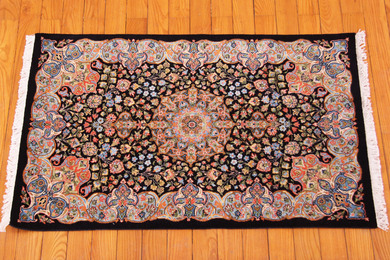![]() View full size image
View full size image
2220838
Blue Kashan
Rug Size: 2' 7" x 4' 2"
Price: This Rug has been sold
Type: Pak-Persian
Quality: 16/16
Ready to purchase?
More questions?
Add to the cart,
then submit your request.
Persian
The Persian rug is the quintessential Oriental rug, famed for its intricacy, knot-density and symbolism. Our Persians are all hand-knotted using a very fine wool from the dhumba sheep dyed with commercially-produced dyes.
Persian rugs are known for their detailed floral designs, sometimes with a pronounced center medallion and sometimes with a repeating all over pattern. Because they are so intricate they tend to have a higher knot count. It's a bit like digital photography: if you have a very detailed image, you need more dots per square inch to show the detail. So, with a very intricate pattern on a rug, you need a lot of knots per square inch to show the design.
Persians are also known for their diverse color pallet. The number of colors in each rug ranges from 15 to 25, giving customers huge flexibility in terms of style and decor. Commonly known Persian designs include Kashan, Kerman, Isfhan and Tabriz.
The name "Persian" sometimes confuses people as our rugs are made in Pakistan, not Iran over which ancient Persia was centered. The reason for this is that when the Moghul empire moved through the Asian subcontinent, people moved from Persia throughout the region taking their designs and traditions with them. The descendants of those artisans passed on their family's rug knotting tradition to these artisans in Pakistan today.
- Knot count: Over 500 knots per square inch with specialty pieces ranging from 800-1250 knots per square inch
- Colors in each rug: 15-25 due to intricate and floral designs
- Composition: 100% wool on a cotton warp and weft. Some pieces will be crafted with a large percentage of silk knots. This will be noted on the price tag as a bundle of silk costs considerably more than the price of wool.
- Type of knot: Senna
- Production: A 9'x12' rug could be completed in 12–14 months by four to five experienced artisans working five to six hours a day. Specialty pieces with higher knot counts would take the same artisans up to 18 months to complete.

